Hydrodeoxygenation of Oxygenates Derived from Biomass Pyrolysis Using Titanium Dioxide-Supported Cobalt Catalysts
Abstract
:1. Introduction
2. Results and Discussion
2.1. Characterization of Catalysts
2.2. The HDO of 4PG
2.2.1. Effect of the Reaction Temperature and Reaction Time
2.2.2. Proposed Reaction Pathway
2.3. The HDO of Other Types of Lignin-Derived Model Compounds
2.4. Reusability
2.5. The HDO of Bio-Oil
3. Materials and Methods
3.1. Materials
3.2. Catalyst Preparation
3.3. Catalyst Characterization
3.4. The HDO of 4PG and Other Lignin-Derived Model Compounds
3.5. Product Analysis
3.6. The HDO of Bio-Oil and Product Analysis
4. Conclusions
Supplementary Materials
Author Contributions
Funding
Institutional Review Board Statement
Informed Consent Statement
Data Availability Statement
Acknowledgments
Conflicts of Interest
References
- Bobylev, S.N.; Solovyeva, S.V. Sustainable development goals for the future of Russia. Stud. Russ. Econ. Dev. 2017, 28, 259–265. [Google Scholar] [CrossRef]
- Zhang, M.; Hu, Y.; Wang, H.; Li, H.; Han, X.; Zeng, Y.; Xu, C.C. A review of bio-oil upgrading by catalytic hydrotreatment: Advances, challenges, and prospects. Mol. Catal. 2021, 504, 111438. [Google Scholar] [CrossRef]
- Popova, M.; Trendafilova, I.; Oykova, M.; Mitrev, Y.; Shestakova, P.; Mihalyi, M.R.; Szegedi, A. Hydrodeoxygenation of levulinic acid to gamma-valerolactone over mesoporous silica-supported Cu-Ni composite catalysts. Molecules 2022, 27, 5383. [Google Scholar] [CrossRef]
- Kim, S.; Kwon, E.E.; Kim, Y.T.; Jung, S.; Kim, H.J.; Huber, G.W.; Lee, J. Recent advances in hydrodeoxygenation of biomass-derived oxygenates over heterogeneous catalysts. Green Chem. 2019, 21, 3715–3743. [Google Scholar] [CrossRef]
- Deng, W.; Feng, Y.; Fu, J.; Guo, H.; Guo, Y.; Han, B.; Jiang, Z.; Kong, L.; Li, C.; Liu, H.; et al. Catalytic conversion of lignocellulosic biomass into chemicals and fuels. Green Energy Environ. 2023, 8, 10–114. [Google Scholar] [CrossRef]
- Zhang, S.; Duan, Y.; Teng, C.; Quan, H.; Yang, X.; Li, H.; Li, X.; Yan, L. Fast and selective degradation of biomass for xylose, glucose and lignin under mild conditions. Molecules 2023, 28, 3306. [Google Scholar] [CrossRef]
- Mu, W.; Ben, H.; Ragauskas, A.; Deng, Y. Lignin pyrolysis components and upgrading—Technology review. BioEnergy Res. 2013, 6, 1183–1204. [Google Scholar] [CrossRef]
- Li, Z.; Zhang, H.; Yang, D.; Hu, Z.; Wang, F.; Zhang, Z. Efficient conversion of lignin to aromatics via catalytic fast pyrolysis over niobium-doped HZSM-5. Molecules 2023, 28, 4245. [Google Scholar] [CrossRef]
- Wang, H.; Pu, Y.; Ragauskas, A.; Yang, B. From lignin to valuable products-strategies, challenges, and prospects. Bioresour. Technol. 2019, 271, 449–461. [Google Scholar] [CrossRef]
- Runnebaum, R.C.; Nimmanwudipong, T.; Block, D.E.; Gates, B.C. Catalytic conversion of compounds representative of lignin-derived bio-oils: A reaction network for guaiacol, anisole, 4-methylanisole, and cyclohexanone conversion catalysed by Pt/γ-Al2O3. Catal. Sci. Technol. 2012, 2, 113–118. [Google Scholar] [CrossRef]
- Song, S.; Zhang, J.; Gozaydin, G.; Yan, N. Production of terephthalic acid from corn stover lignin. Angew. Chem.-Int. Edit. 2019, 58, 4934–4937. [Google Scholar] [CrossRef] [PubMed]
- Nunes, R.F.; Costa, D.; Ferraria, A.M.; Botelho do Rego, A.M.; Ribeiro, F.; Martins, A.; Fernandes, A. Heterogenization of heteropolyacid with metal-based alumina supports for the guaiacol gas-phase hydrodeoxygenation. Molecules 2023, 28, 2245. [Google Scholar] [CrossRef] [PubMed]
- Jing, Y.; Dong, L.; Guo, Y.; Liu, X.; Wang, Y. Chemicals from lignin: A review of catalytic conversion involving hydrogen. ChemSusChem 2020, 13, 4181–4198. [Google Scholar] [CrossRef]
- Ouedraogo, A.S.; Bhoi, P.R. Recent progress of metals supported catalysts for hydrodeoxygenation of biomass derived pyrolysis oil. J. Clean Prod. 2020, 253, 119957. [Google Scholar] [CrossRef]
- Zhang, J.; Sun, J.; Wang, Y. Recent advances in the selective catalytic hydrodeoxygenation of lignin-derived oxygenates to arenes. Green Chem. 2020, 22, 1072–1098. [Google Scholar] [CrossRef]
- Popova, M.; Szegedi, A.; Oykova, M.; Lazarova, H.; Koseva, N.; Mihalyi, M.R.; Shestakova, P. Selective production of phenol on bifunctional, hierarchical ZSM-5 zeolites. Molecules 2021, 26, 3576. [Google Scholar] [CrossRef]
- Cao, J.; Wang, S.; Li, J.; Xing, Y.; Zhao, X.; Li, D. Porous nanosheets assembled Co3O4 hierarchical architectures for enhanced BTX (benzene, toluene and xylene) gas detection. Sens. Actuators B Chem. 2020, 315, 128120. [Google Scholar] [CrossRef]
- Cheng, F.; Brewer, C.E. Producing jet fuel from biomass lignin: Potential pathways to alkyl-benzenes and cycloalkanes. Renew. Sust. Energy Rev. 2017, 72, 673–722. [Google Scholar] [CrossRef]
- Shu, R.; Lin, B.; Wang, C.; Zhang, J.; Cheng, Z.; Chen, Y. Upgrading phenolic compounds and bio-oil through hydrodeoxygenation using highly dispersed Pt/TiO2 catalyst. Fuel 2019, 239, 1083–1090. [Google Scholar] [CrossRef]
- Zhao, C.; Lercher, J.A. Selective hydrodeoxygenation of lignin-derived phenolic monomers and dimers to cycloalkanes on Pd/C and HZSM-5 catalysts. ChemCatChem 2012, 4, 64–68. [Google Scholar] [CrossRef]
- Omotoso, T.; Boonyasuwat, S.; Crossley, S.P. Understanding the role of TiO2 crystal structure on the enhanced activity and stability of Ru/TiO2 catalysts for the conversion of lignin-derived oxygenates. Green Chem. 2014, 16, 645–652. [Google Scholar] [CrossRef]
- Shu, R.; Lin, B.; Zhang, J.; Wang, C.; Yang, Z.; Chen, Y. Efficient catalytic hydrodeoxygenation of phenolic compounds and bio-oil over highly dispersed Ru/TiO2. Fuel Process. Technol. 2019, 184, 12–18. [Google Scholar] [CrossRef]
- Nava, R.; Pawelec, B.; Castaño, P.; Álvarez-Galván, M.C.; Loricera, C.V.; Fierro, J.L.G. Upgrading of bio-liquids on different mesoporous silica-supported CoMo catalysts. Appl. Catal. B-Environ. 2009, 92, 154–167. [Google Scholar] [CrossRef]
- Mukundan, S.; Atanda, L.; Beltramini, J. Thermocatalytic cleavage of C–C and C–O bonds in model compounds and kraft lignin by NiMoS2/C nanocatalysts. Sustain. Energy Fuels 2019, 3, 1317–1328. [Google Scholar] [CrossRef]
- Mukundan, S.; Wahab, M.A.; Atanda, L.; Konarova, M.; Beltramini, J. Highly active and robust Ni–MoS2 supported on mesoporous carbon: A nanocatalyst for hydrodeoxygenation reactions. RSC Adv. 2019, 9, 17194–17202. [Google Scholar] [CrossRef] [PubMed]
- Wu, K.; Liu, Y.; Wang, W.; Huang, Y.; Li, W.; Shi, Q.; Yang, Y. Preparation of hydrophobic MoS2, NiS2-MoS2 and CoS2-MoS2 for catalytic hydrodeoxygenation of lignin-derived phenols. Mol. Catal. 2019, 477, 110537. [Google Scholar] [CrossRef]
- Liu, X.; Xu, L.; Xu, G.; Jia, W.; Ma, Y.; Zhang, Y. Selective hydrodeoxygenation of lignin-derived phenols to cyclohexanols or cyclohexanes over magnetic CoNx@NC catalysts under mild conditions. ACS Catal. 2016, 6, 7611–7620. [Google Scholar] [CrossRef]
- Lu, M.; Sun, Y.; Zhang, P.; Zhu, J.; Li, M.; Shan, Y.; Shen, J.; Song, C. Hydrodeoxygenation of guaiacol catalyzed by high-loading Ni catalysts supported on SiO2–TiO2 binary oxides. Ind. Eng. Chem. Res. 2019, 58, 1513–1524. [Google Scholar] [CrossRef]
- Ding, Z.; Zhao, T.; Zhu, Q.; Liao, S.; Ning, L.; Bi, Y.; Chen, H. Facile synthesis cobalt catalysts for regulating the deoxygenation pathways in producing diesel-like hydrocarbon fuels. Biomass Bioenerg. 2020, 143, 105879. [Google Scholar] [CrossRef]
- Ghampson, I.T.; Sepúlveda, C.; Dongil, A.B.; Pecchi, G.; García, R.; Fierro, J.L.G.; Escalona, N. Phenol hydrodeoxygenation: Effect of support and Re promoter on the reactivity of Co catalysts. Catal. Sci. Technol. 2016, 6, 7289–7306. [Google Scholar] [CrossRef]
- Tran, N.T.T.; Uemura, Y.; Ramli, A. Hydrodeoxygenation of guaiacol over Al-MCM-41 supported metal catalysts: A comparative study of Co and Ni. Procedia Eng. 2016, 148, 1252–1258. [Google Scholar] [CrossRef]
- Jin, W.; Pastor-Pérez, L.; Shen, D.; Sepúlveda-Escribano, A.; Gu, S.; Ramirez Reina, T. Catalytic upgrading of biomass model compounds: Novel approaches and lessons learnt from traditional hydrodeoxygenation—A review. ChemCatChem 2019, 11, 924–960. [Google Scholar] [CrossRef]
- Héroguel, F.; Nguyen, X.T.; Luterbacher, J.S. Catalyst support and solvent effects during lignin depolymerization and hydrodeoxygenation. ACS Sustain. Chem. Eng. 2019, 7, 16952–16958. [Google Scholar] [CrossRef]
- Oi, L.E.; Choo, M.-Y.; Lee, H.V.; Ong, H.C.; Hamid, S.B.A.; Juan, J.C. Recent advances of titanium dioxide (TiO2) for green organic synthesis. RSC Adv. 2016, 6, 108741–108754. [Google Scholar] [CrossRef]
- Yang, Y.X.; Hao, J.S.; Lv, G.Q. Comparative study of catalytic hydrodeoxygenation performance over SBA-15 and TiO2 supported 20 wt% Ni for bio-oil upgrading. Fuel 2019, 253, 630–636. [Google Scholar] [CrossRef]
- Lu, M.; Du, H.; Wei, B.; Zhu, J.; Li, M.; Shan, Y.; Song, C. Catalytic hydrodeoxygenation of guaiacol over palladium catalyst on different titania supports. Energy Fuels 2017, 31, 10858–10865. [Google Scholar] [CrossRef]
- Mao, J.; Zhou, J.; Xia, Z.; Wang, Z.; Xu, Z.; Xu, W.; Yan, P.; Liu, K.; Guo, X.; Zhang, Z.C. Anatase TiO2 activated by gold nanoparticles for selective hydrodeoxygenation of guaiacol to phenolics. ACS Catal. 2017, 7, 695–705. [Google Scholar] [CrossRef]
- Hernandez-Mejia, C.; Gnanakumar, E.S.; Olivos-Suarez, A.; Gascon, J.; Greer, H.F.; Zhou, W.; Rothenberg, G.; Raveendran Shiju, N. Ru/TiO2-catalysed hydrogenation of xylose: The role of the crystal structure of the support. Catal. Sci. Technol. 2016, 6, 577–582. [Google Scholar] [CrossRef]
- Zhang, X.; Yan, P.; Zhao, B.; Liu, K.; Kung, M.C.; Kung, H.H.; Chen, S.; Zhang, Z.C. Selective hydrodeoxygenation of guaiacol to phenolics by Ni/anatase TiO2 catalyst formed by cross-surface migration of Ni and TiO2. ACS Catal. 2019, 9, 3551–3563. [Google Scholar] [CrossRef]
- Liu, X.; Jia, W.; Xu, G.; Zhang, Y.; Fu, Y. Selective hydrodeoxygenation of lignin-derived phenols to cyclohexanols over Co-based catalysts. ACS Sustain. Chem. Eng. 2017, 5, 8594–8601. [Google Scholar] [CrossRef]
- Lindfors, C.; Mäki-Arvela, P.; Paturi, P.; Aho, A.; Eränen, K.; Hemming, J.; Peurla, M.; Kubička, D.; Simakova, I.L.; Murzin, D.Y. Hydrodeoxygenation of isoeugenol over Ni- and Co-supported catalysts. ACS Sustain. Chem. Eng. 2019, 7, 14545–14560. [Google Scholar] [CrossRef]
- Cychosz, K.A.; Guillet-Nicolas, R.; Garcia-Martinez, J.; Thommes, M. Recent advances in the textural characterization of hierarchically structured nanoporous materials. Chem. Soc. Rev. 2017, 46, 389–414. [Google Scholar] [CrossRef] [PubMed]
- Chintakanan, P.; Vitidsant, T.; Reubroycharoen, P.; Kuchonthara, P.; Kida, T.; Hinchiranan, N. Bio-jet fuel range in biofuels derived from hydroconversion of palm olein over Ni/zeolite catalysts and freezing point of biofuels/Jet A-1 blends. Fuel 2021, 293, 120472. [Google Scholar] [CrossRef]
- Reuel, R.C.; Bartholomew, C.H. The stoichiometries of H2 and CO adsorptions on cobalt: Effects of support and preparation. J. Catal. 1984, 85, 63–77. [Google Scholar] [CrossRef]
- Gai, H.; Wang, H.; Liu, L.; Feng, B.; Xiao, M.; Tang, Y.; Qu, X.; Song, H.; Huang, T. Potassium and iodide codoped mesoporous titanium dioxide for enhancing photocatalytic degradation of phenolic compounds. Chem. Phys. Lett. 2021, 767, 138367. [Google Scholar] [CrossRef]
- El-Sherbiny, S.; Morsy, F.; Samir, M.; Fouad, O.A. Synthesis, characterization and application of TiO2 nanopowders as special paper coating pigment. Appl. Nanosci. 2014, 4, 305–313. [Google Scholar] [CrossRef]
- Eagan, N.M.; Chada, J.P.; Wittrig, A.M.; Buchanan, J.S.; Dumesic, J.A.; Huber, G.W. Hydrodeoxygenation of sorbitol to monofunctional fuel precursors over Co/TiO2. Joule 2017, 1, 178–199. [Google Scholar] [CrossRef]
- Cardenas Flechas, L.J.; Raba Paéz, A.M.; Rincon Joya, M. Synthesis and evaluation of nickel doped Co3O4 produced through hydrothermal technique. Dyna 2020, 87, 184–191. [Google Scholar] [CrossRef]
- Hanaor, D.A.H.; Sorrell, C.C. Review of the anatase to rutile phase transformation. J. Mater. Sci. 2010, 46, 855–874. [Google Scholar] [CrossRef]
- Tolek, W.; Nanthasanti, N.; Pongthawornsakun, B.; Praserthdam, P.; Panpranot, J. Effects of TiO2 structure and Co addition as a second metal on Ru-based catalysts supported on TiO2 for selective hydrogenation of furfural to FA. Sci. Rep. 2021, 11, 9786. [Google Scholar] [CrossRef]
- Bratan, V.; Munteanu, C.; Hornoiu, C.; Vasile, A.; Papa, F.; State, R.; Preda, S.; Culita, D.; Ionescu, N.I. CO oxidation over Pd supported catalysts —In Situ study of the electric and catalytic properties. Appl. Catal. B-Environ. 2017, 207, 166–173. [Google Scholar] [CrossRef]
- Sabat, K.C.; Paramguru, R.K.; Pradhan, S.; Mishra, B.K. Reduction of cobalt oxide (Co3O4) by low temperature hydrogen plasma. Plasma Chem. Plasma Process. 2015, 35, 387–399. [Google Scholar] [CrossRef]
- Bhavani, A.G.; Kim, W.Y.; Kim, J.Y.; Lee, J.S. Improved activity and coke resistance by promoters of nanosized trimetallic catalysts for autothermal carbon dioxide reforming of methane. Appl. Catal. A-Gen. 2013, 450, 63–72. [Google Scholar] [CrossRef]
- Bi, X.; Du, G.; Kalam, A.; Sun, D.; Yu, Y.; Su, Q.; Xu, B.; Al-Sehemi, A.G. Tuning oxygen vacancy content in TiO2 nanoparticles to enhance the photocatalytic performance. Chem. Eng. Sci. 2021, 234, 116440. [Google Scholar] [CrossRef]
- Chanda, A.; Rout, K.; Vasundhara, M.; Joshi, S.R.; Singh, J. Structural and magnetic study of undoped and cobalt doped TiO2 nanoparticles. RSC Adv. 2018, 8, 10939–10947. [Google Scholar] [CrossRef] [PubMed]
- Zhu, L.; Lu, Q.; Lv, L.; Wang, Y.; Hu, Y.; Deng, Z.; Lou, Z.; Hou, Y.; Teng, F. Ligand-free rutile and anatase TiO2 nanocrystals as electron extraction layers for high performance inverted polymer solar cells. RSC Adv. 2017, 7, 20084–20092. [Google Scholar] [CrossRef]
- Jackman, M.J.; Thomas, A.G.; Muryn, C. Photoelectron spectroscopy study of stoichiometric and reduced anatase TiO2(101) surfaces: The effect of subsurface defects on water adsorption at near-ambient pressures. J. Phys. Chem. C 2015, 119, 13682–13690. [Google Scholar] [CrossRef]
- Kruse, N.; Chenakin, S. XPS characterization of Au/TiO2 catalysts: Binding energy assessment and irradiation effects. Appl. Catal. A-Gen. 2011, 391, 367–376. [Google Scholar] [CrossRef]
- Mehta, M.; Kodan, N.; Kumar, S.; Kaushal, A.; Mayrhofer, L.; Walter, M.; Moseler, M.; Dey, A.; Krishnamurthy, S.; Basu, S.; et al. Hydrogen treated anatase TiO2: A new experimental approach and further insights from theory. J. Mater. Chem. A 2016, 4, 2670–2681. [Google Scholar] [CrossRef]
- Rekoske, J.E.; Barteau, M.A. Isothermal reduction kinetics of titanium dioxide-based materials. J. Phys. Chem. B 1997, 101, 1113–1124. [Google Scholar] [CrossRef]
- Kim, H.; Park, J.H.; Ha, J.-M.; Kim, D.H. Effect of hydrogen spillover on the Ru/TiO2-catalyzed guaiacol hydrodeoxygenation: Rutile vs anatase TiO2. ACS Catal. 2023, 13, 11857–11870. [Google Scholar] [CrossRef]
- Pan, X.; Yang, M.Q.; Fu, X.; Zhang, N.; Xu, Y.J. Defective TiO2 with oxygen vacancies: Synthesis, properties and photocatalytic applications. Nanoscale 2013, 5, 3601–3614. [Google Scholar] [CrossRef]
- Azzi, H.; Rekkab-Hammoumraoui, I.; Chérif-Aouali, L.; Choukchou-Braham, A. Mesoporous Co3O4 as a new catalyst for allylic oxidation of cyclohexene. Bull. Chem. React. Eng. Catal. 2019, 14, 112–123. [Google Scholar] [CrossRef]
- Banerjee, A.; Mushrif, S.H. Reaction pathways for the deoxygenation of biomass-pyrolysis-derived bio-oil on Ru: A DFT study using furfural as a model compound. ChemCatChem 2017, 9, 2828–2838. [Google Scholar] [CrossRef]
- Yang, H.; Yin, W.; Zhu, X.; Deuss, P.J.; Heeres, H.J. Selective demethoxylation of guaiacols to phenols using supported MoO3 catalysts. ChemCatChem 2022, 14, e2022002. [Google Scholar] [CrossRef]
- Yan, P.; Li, M.M.-J.; Kennedy, E.; Adesina, A.; Zhao, G.; Setiawan, A.; Stockenhuber, M. The role of acid and metal sites in hydrodeoxygenation of guaiacol over Ni/Beta catalysts. Catal. Sci. Technol. 2020, 10, 810–825. [Google Scholar] [CrossRef]
- Cheah, Y.W.; Salam, M.A.; Arora, P.; Öhrman, O.; Creaser, D.; Olsson, L. Role of transition metals on MoS2-based supported catalysts for hydrodeoxygenation (HDO) of propylguaiacol. Sustain. Energy Fuels 2021, 5, 2097–2113. [Google Scholar] [CrossRef]
- Mäki-Arvela, P.; Murzin, D. Hydrodeoxygenation of lignin-derived phenols: From fundamental studies towards industrial applications. Catalysts 2017, 7, 265. [Google Scholar] [CrossRef]
- Lu, M.; Zhu, J.; Li, M.; Shan, Y.; He, M.; Song, C. TiO2-modified Pd/SiO2 for catalytic hydrodeoxygenation of guaiacol. Energy Fuels 2016, 30, 6671–6676. [Google Scholar] [CrossRef]
- Mortensen, P.M.; Grunwaldt, J.-D.; Jensen, P.A.; Jensen, A.D. Influence on nickel particle size on the hydrodeoxygenation of phenol over Ni/SiO2. Catal. Today 2016, 259, 277–284. [Google Scholar] [CrossRef]
- Phan, T.N.; Park, Y.-K.; Lee, I.-G.; Ko, C.H. Enhancement of CO bond cleavage to afford aromatics in the hydrodeoxygenation of anisole over ruthenium-supporting mesoporous metal oxides. Appl. Catal. A-Gen. 2017, 544, 84–93. [Google Scholar] [CrossRef]
- Kumar, A.; Anushree; Kumar, J.; Bhaskar, T. Utilization of lignin: A sustainable and eco-friendly approach. J. Energy Inst. 2020, 93, 235–271. [Google Scholar] [CrossRef]
- Jha, A.; Lee, Y.-L.; Jang, W.-J.; Shim, J.-O.; Jeon, K.-W.; Na, H.-S.; Kim, H.-M.; Roh, H.-S.; Jeong, D.-W.; Jeon, S.G.; et al. Effect of the redox properties of support oxide over cobalt-based catalysts in high temperature water-gas shift reaction. Mol. Catal. 2017, 433, 145–152. [Google Scholar] [CrossRef]
- Baraj, E.; Ciahotný, K.; Hlinčík, T. The water gas shift reaction: Catalysts and reaction mechanism. Fuel 2021, 288, 119817. [Google Scholar] [CrossRef]
- Hu, X.; Zhang, Z.; Gholizadeh, M.; Zhang, S.; Lam, C.H.; Xiong, Z.; Wang, Y. Coke formation during thermal treatment of bio-oil. Energy Fuels 2020, 34, 7863–7914. [Google Scholar] [CrossRef]
- Carlson, T.R.; Jae, J.; Lin, Y.-C.; Tompsett, G.A.; Huber, G.W. Catalytic fast pyrolysis of glucose with HZSM-5: The combined homogeneous and heterogeneous reactions. J. Catal. 2010, 270, 110–124. [Google Scholar] [CrossRef]
- Sherbi, M.; Stuckart, M.; Albert, J. Selective catalytic hydrogenation of biomass derived furans to secondary alcohols using Pt/polyoxometalate catalysts under mild reaction conditions. Biofuels Bioprod. Biorefining 2021, 15, 1431–1446. [Google Scholar] [CrossRef]
- Bagnato, G.; Sanna, A.; Paone, E.; Catizzone, E. Recent catalytic advances in hydrotreatment processes of pyrolysis bio-oil. Catalysts 2021, 11, 157. [Google Scholar] [CrossRef]
- Liu, C.; Wang, H.; Karim, A.M.; Sun, J.; Wang, Y. Catalytic fast pyrolysis of lignocellulosic biomass. Chem. Soc. Rev. 2014, 43, 7594–7623. [Google Scholar] [CrossRef]
- Rogers, K.A.; Zheng, Y. Selective deoxygenation of biomass-derived bio-oils within hydrogen-modest environments: A review and new insights. ChemSusChem 2016, 9, 1750–1772. [Google Scholar] [CrossRef]
- Zhang, X.; Wang, Y.; Xin, F. Coke deposition and characterization on titanium silicalite-1 catalyst in cyclohexanone ammoximation. Appl. Catal. A-Gen. 2006, 307, 222–230. [Google Scholar] [CrossRef]
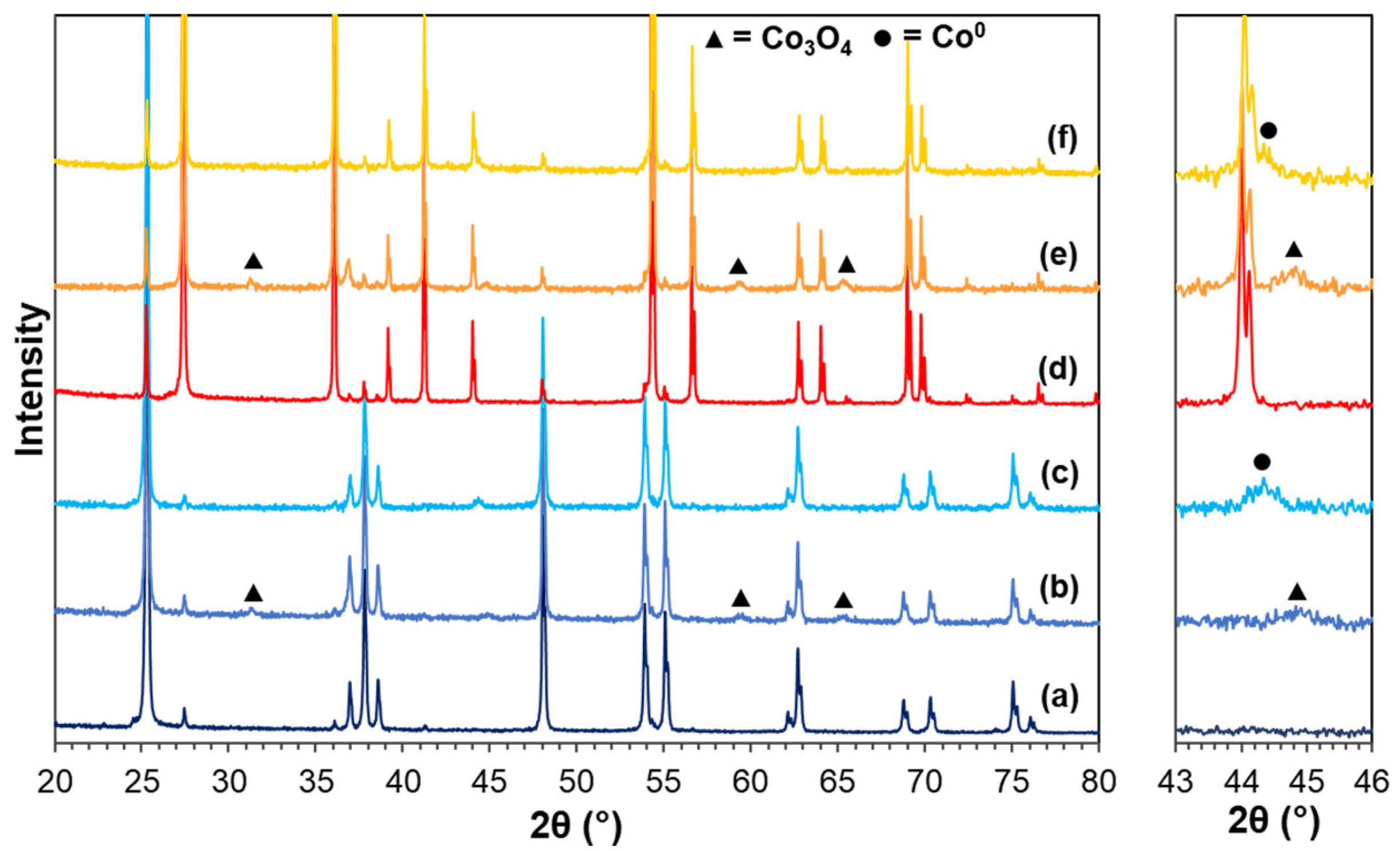
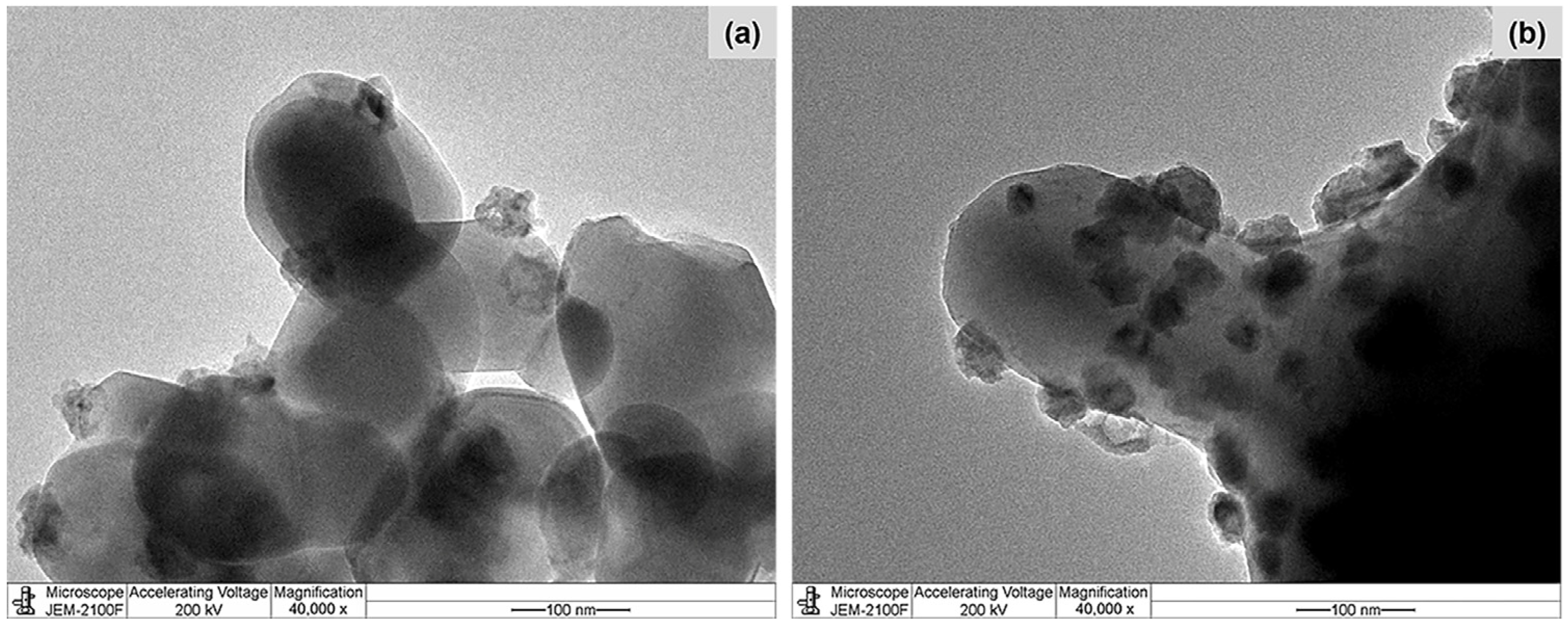
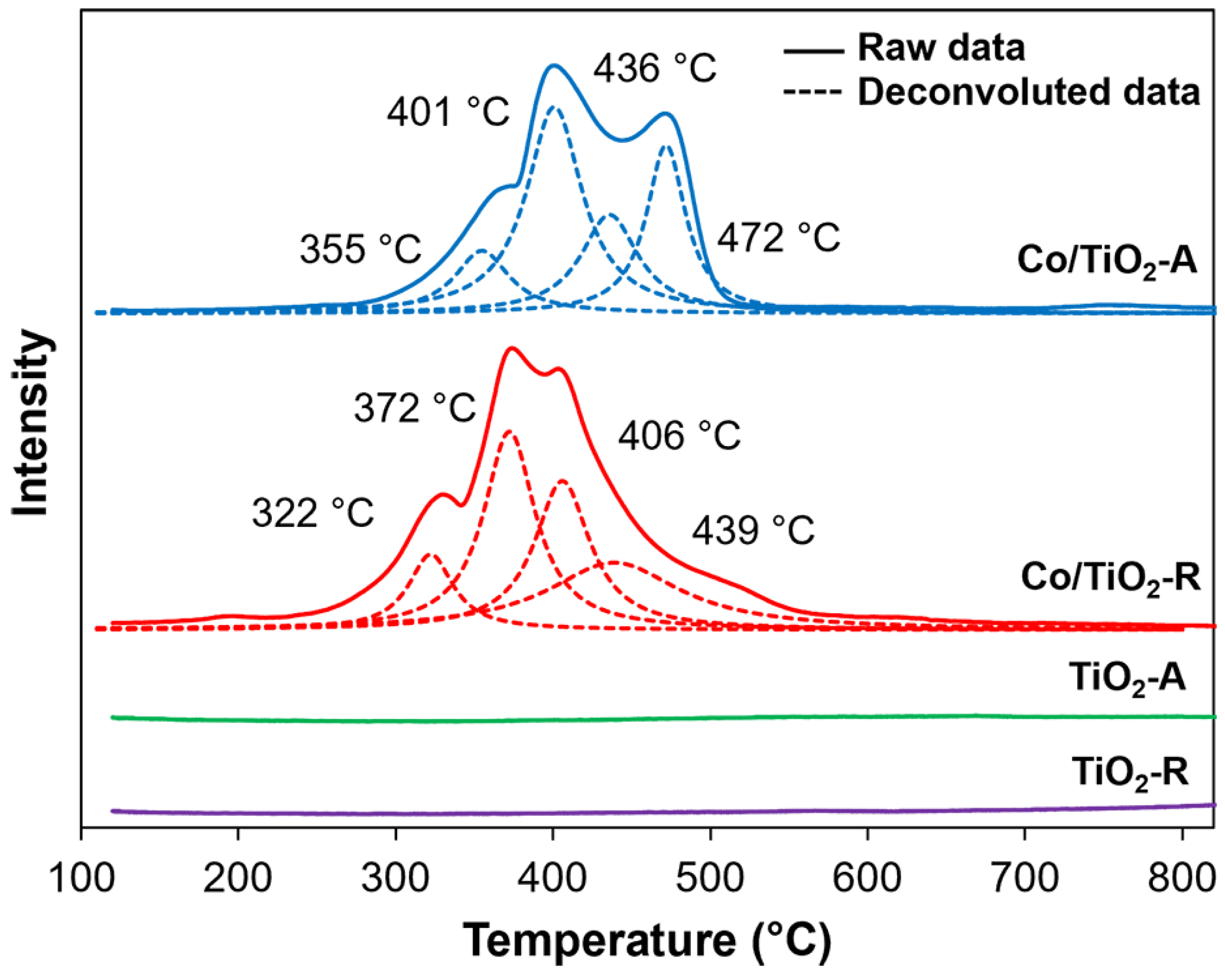
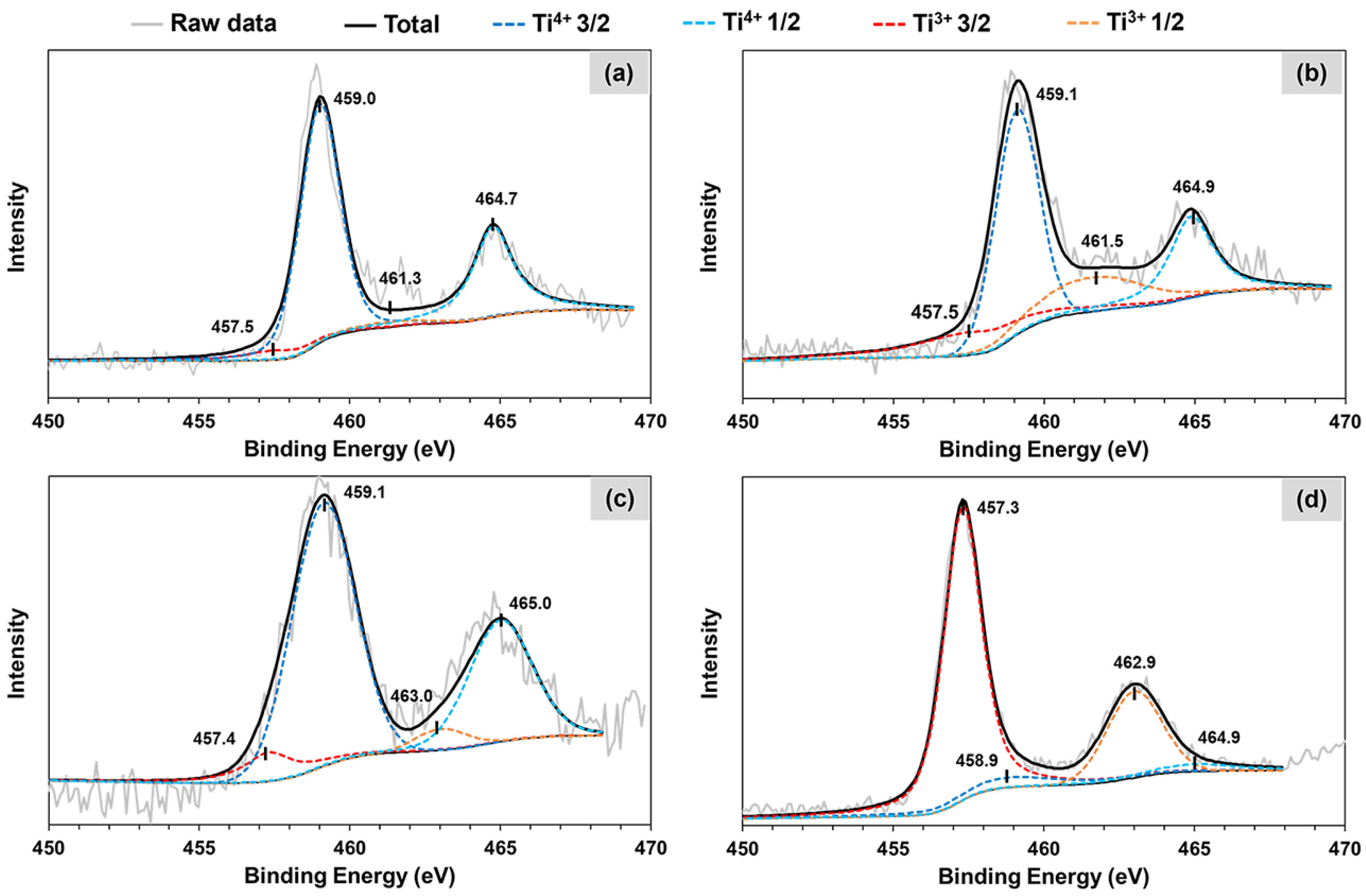
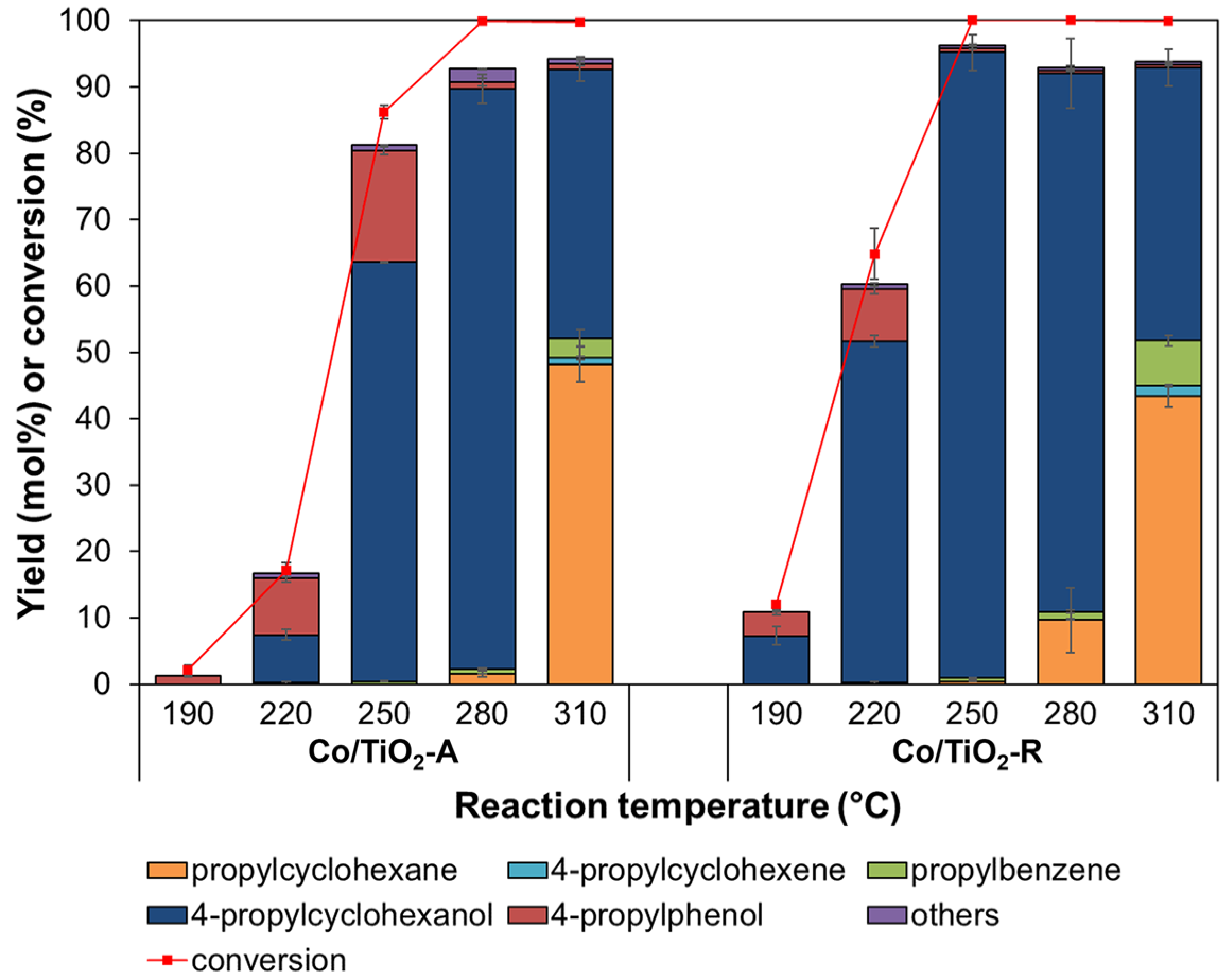

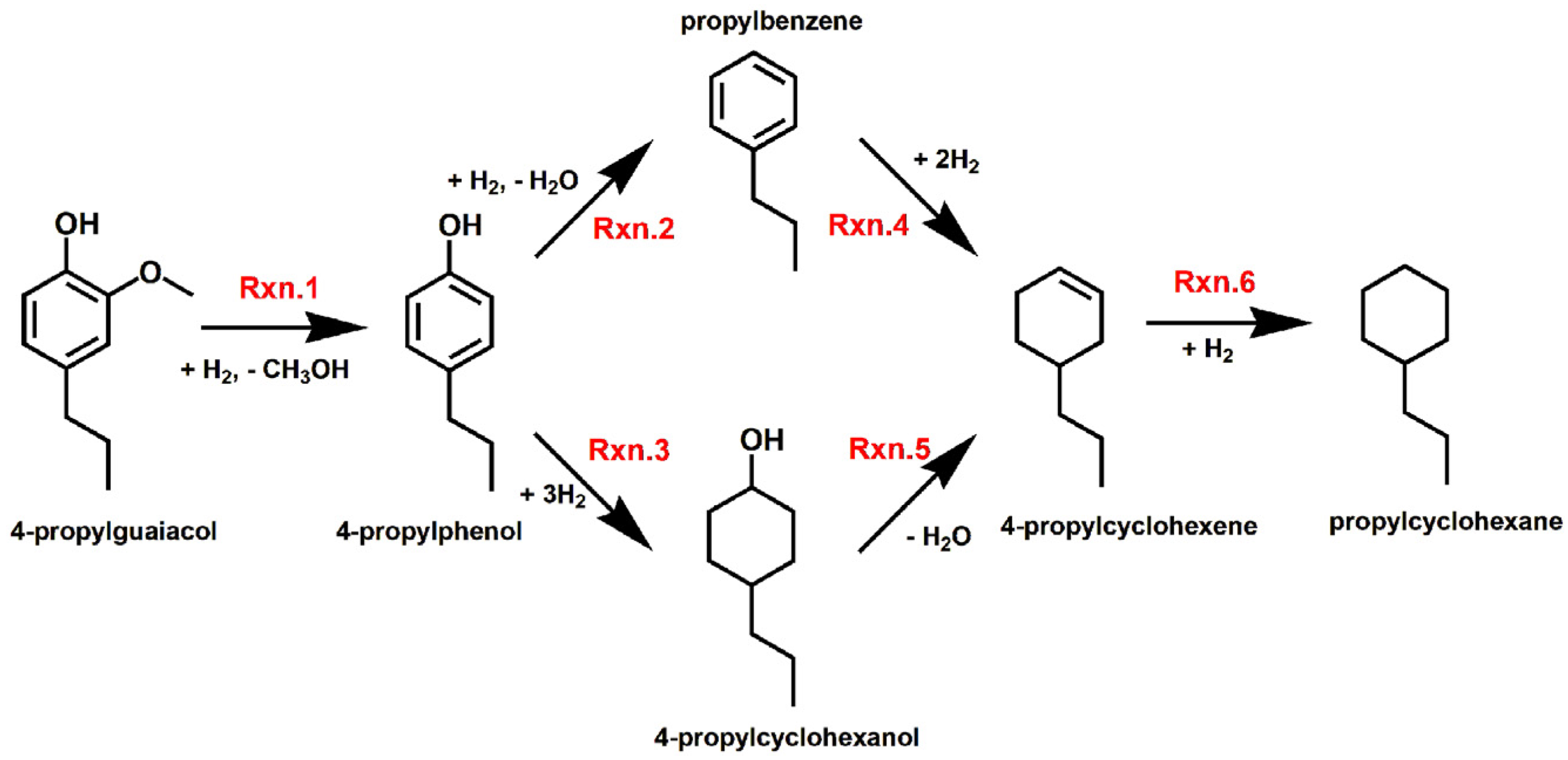
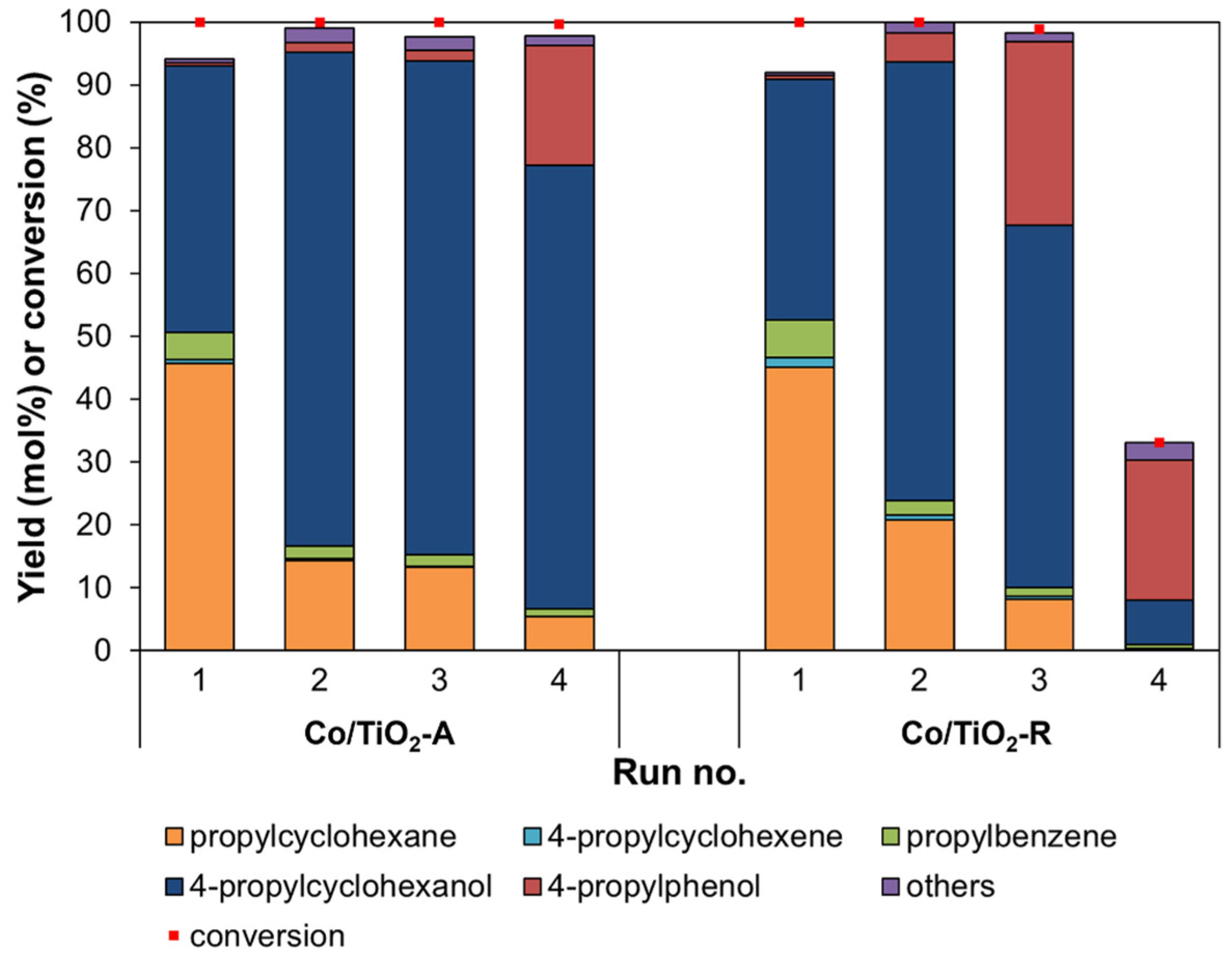
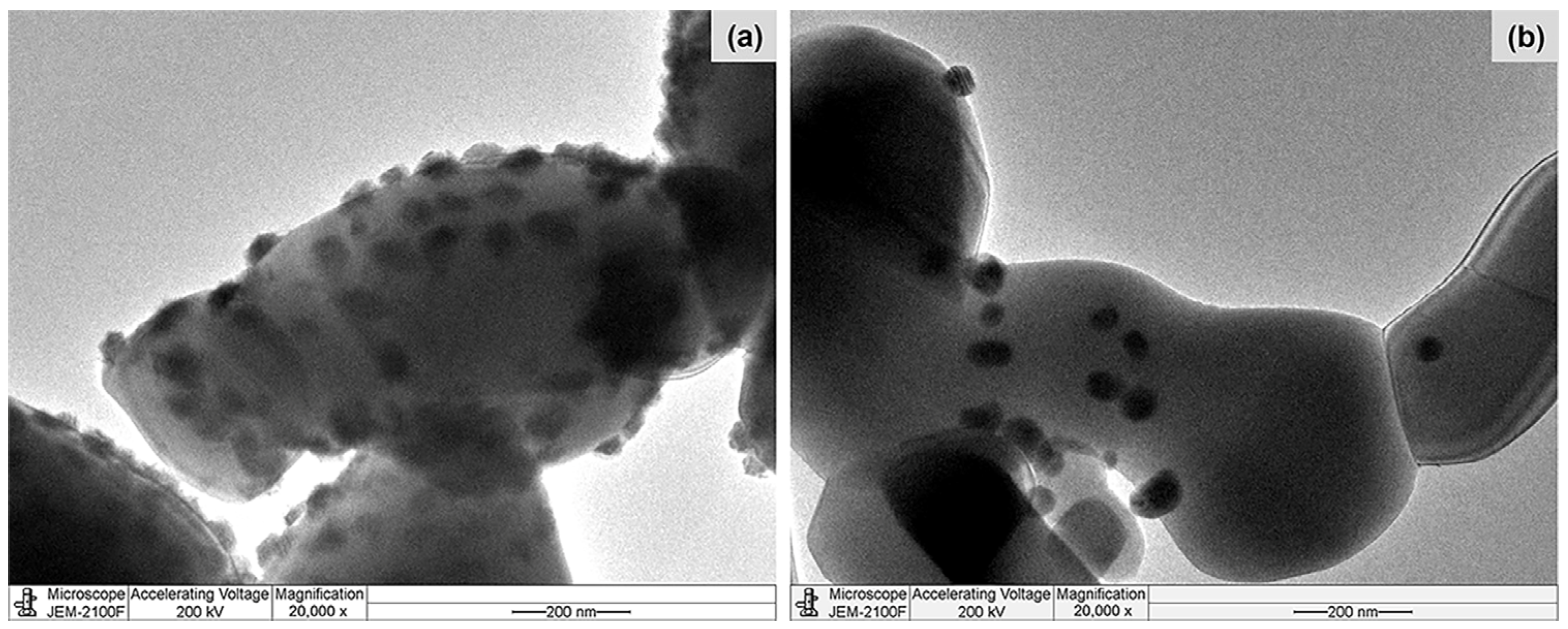
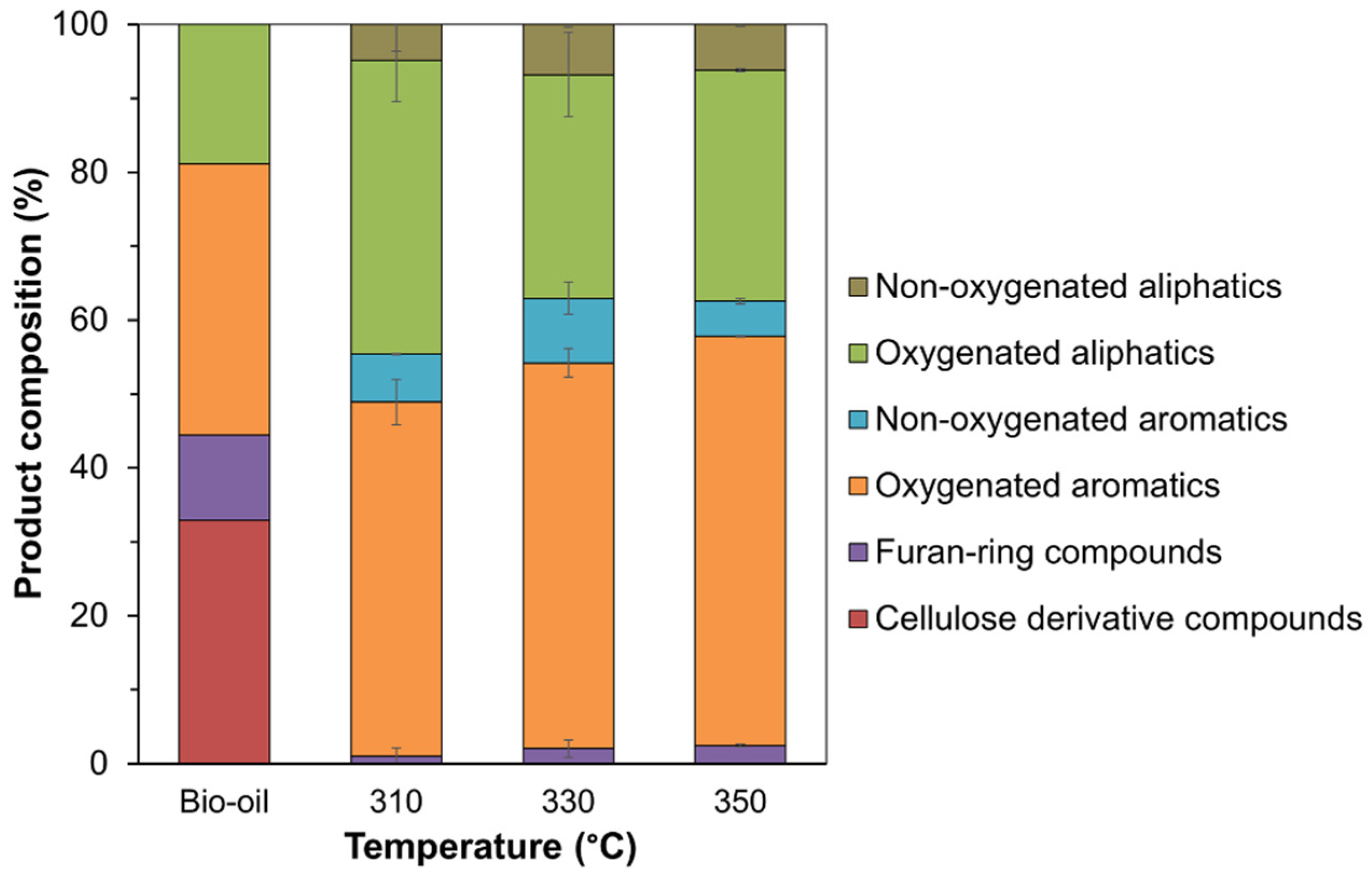


| Sample | Co Amount a | SBET b | Vp c | rp d | dCo e | DCo f |
|---|---|---|---|---|---|---|
| (wt%) | (m2/g) | (cm3/g) | (nm) | (nm) | (%) | |
| TiO2-A | - | 9.81 | 0.0156 | 1.92 | - | - |
| Co/TiO2-A | 4.92 | 10.4 | 0.0173 | 1.54 | 19.1 | 5.02 |
| TiO2-R | - | 2.92 | 0.0052 | 1.93 | - | - |
| Co/TiO2-R | 4.59 | 4.19 | 0.0081 | 1.53 | 27.0 | 3.56 |
| Sample | H2 Consumption a | Reducibility b | Acidity c (µmol NH3/g Catalyst) | |||
|---|---|---|---|---|---|---|
| (mmol/g Catalyst) | (%) | Weak | Medium | Strong | Total | |
| TiO2-A | - | - | 30 | 9 | 6 | 45 |
| Calcined Co/TiO2-A | 1.06 | 95.4 | 40 | 18 | 14 | 72 |
| Reduced Co/TiO2-A | - | - | 36 | 9 | 11 | 56 |
| TiO2-R | - | - | 14 | 10 | 6 | 30 |
| Calcined Co/TiO2-R | 1.17 | 112.8 | 17 | 11 | 15 | 46 |
| Reduced Co/TiO2-R | - | - | 12 | 7 | 12 | 31 |
| Sample | Peak Area (%) | Ova (%) | ||||
|---|---|---|---|---|---|---|
| Co 2p | Ti 2p | |||||
| Co0 | CoOx | CoOx Satellite | Ti3+ | Ti4+ | ||
| Calcined Co/TiO2-A | 1.72 | 49.1 | 49.2 | 7.83 | 92.2 | 1.96 |
| Reduced Co/TiO2-A | 58.7 | 32.8 | 8.50 | 26.9 | 73.1 | 8.22 |
| Calcined Co/TiO2-R | 1.74 | 45.3 | 52.9 | 11.5 | 88.5 | 2.87 |
| Reduced Co/TiO2-R | 51.4 | 29.4 | 19.2 | 89.8 | 10.2 | 22.0 |
Disclaimer/Publisher’s Note: The statements, opinions and data contained in all publications are solely those of the individual author(s) and contributor(s) and not of MDPI and/or the editor(s). MDPI and/or the editor(s) disclaim responsibility for any injury to people or property resulting from any ideas, methods, instructions or products referred to in the content. |
© 2023 by the authors. Licensee MDPI, Basel, Switzerland. This article is an open access article distributed under the terms and conditions of the Creative Commons Attribution (CC BY) license (https://creativecommons.org/licenses/by/4.0/).
Share and Cite
Hongkailers, S.; Pattiya, A.; Hinchiranan, N. Hydrodeoxygenation of Oxygenates Derived from Biomass Pyrolysis Using Titanium Dioxide-Supported Cobalt Catalysts. Molecules 2023, 28, 7468. https://doi.org/10.3390/molecules28227468
Hongkailers S, Pattiya A, Hinchiranan N. Hydrodeoxygenation of Oxygenates Derived from Biomass Pyrolysis Using Titanium Dioxide-Supported Cobalt Catalysts. Molecules. 2023; 28(22):7468. https://doi.org/10.3390/molecules28227468
Chicago/Turabian StyleHongkailers, Surachet, Adisak Pattiya, and Napida Hinchiranan. 2023. "Hydrodeoxygenation of Oxygenates Derived from Biomass Pyrolysis Using Titanium Dioxide-Supported Cobalt Catalysts" Molecules 28, no. 22: 7468. https://doi.org/10.3390/molecules28227468





